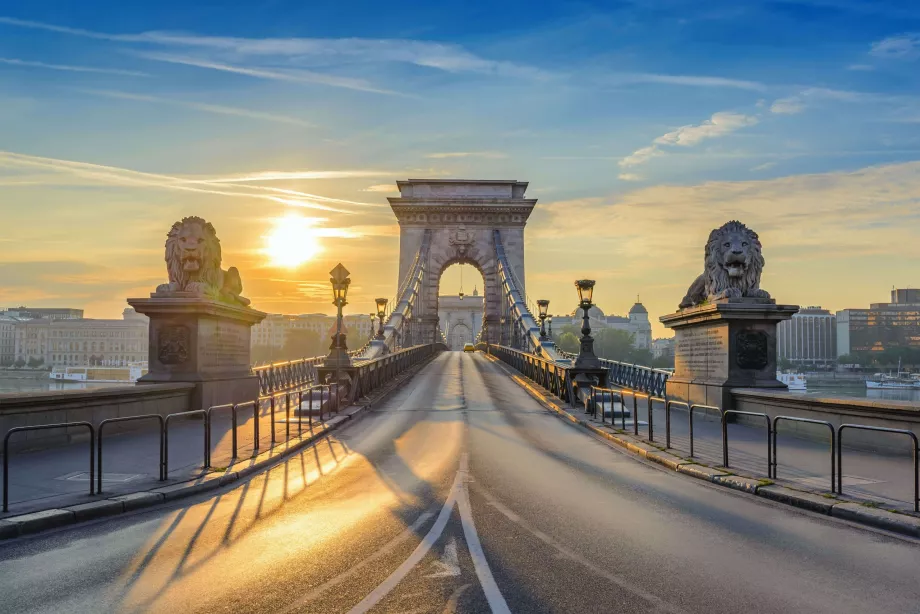Getting around Budapest

Budapest is a large city and the walking distances between sights are quite long.
However, the city has a very good and well-organised public transport system, which includes 4 metro lines, blue buses, red trolleybuses, yellow trams, and the city's "H" or "S" railway, which can be used with regular tickets.
The 10 best hotels in Budapest
The popular boat lines D11, D12 and D13 are no longer in service.
Maps, timetables and other information can be found on the official website bkk.hu.
Public transport tickets
The public transport system in Budapest is operated by the BKV transport company and covered by the transport organiser BKK.
Uniform ticket types can be used on all public transport vehicles integrated into the public transport system. Each ticket allows you to transfer freely between all modes of transport within its time validity.
Ticket prices in Budapest
Below we list the tickets that are valid within the city limits of Budapest, which will be enough for you to visit all the tourist attractions. Multi-day tickets are valid on the ferry lines D2, D11 and D12 only on weekdays, while you have to buy a separate ticket at the weekend.
Children under 6 and seniors over 65 from anywhere in the EU ride for free.
| 24-hour ticket | 2 750 huf |
|---|---|
| 72-hour ticket | 5 750 huf |
| 90-minute ticket | 850 huf* |
| 30-minute ticket | 600 huf* |
| 1 ride (transfer only possible between metro lines) |
500 huf |
* Can only be purchased on the BudapestGo mobile app.
For a complete list of tickets, visit bkk.hu/en/tickets-and-passes/prices.
Where to buy tickets and how to use them?
In Budapest you can use 2 alternatives to buy tickets.
Paper tickets
You can buy public transport tickets from vending machines located in metro stations and major stops, and you can also pay with a card. Alternatively, you can buy tickets at newsagents, some grocery stores and other outlets. A list of all vending machines and kiosks can be found at bkk.hu/pontkereso.
Paper tickets must always be marked when they are first used by inserting them into the yellow electronic or red manual validators.
Validators are inside buses, trams and trolleybuses, and in the metro or on trains you have to 'click' your ticket before entering the platform. Detailed information on the official website.
Mobile tickets
A more modern option is to use mobile tickets. All types of tickets are available on the BudapestGo mobile app. However, you need to have an internet connection at all times to use them.
You have to validate the ticket purchased via BudapestGo when boarding the tram/bus or when entering the metro/train platform.
You can use the QR code scanned at the reader for validation. A faster option is via NFC technology, where you simply put your phone to the reader without ever having to open the app
Download the BudapestGo mobile app on Google Play / App Store.
Where can I pay for tickets everywhere?
All of the above tickets are valid for the entire administrative boundaries of Budapest. This border is shown by a red dotted line on google.com/maps, for example.
You can also use the tickets on all regional buses that leave Budapest from outside the city, but only when travelling within the Budapest city limits. If you continue out of the city, you will also need to buy the appropriate ticket from the driver (in the case of buses) or from the ticket machine on the platform (in the case of trains).
Searching for connections
If you need to find a connection, use the simple website of the BKK transport organiser: bkk.hu. On the right side of the website you can search for a connection by specifying the starting and destination stop.
You can also use the BudapestGo mobile app.
Metro
Budapest has four underground metro lines. Three of them (M1 - yellow, M2 - red and M3 - blue) cross only at Deák Ferenc tér. The new line M4 - green crosses with M2 at Keleti pálayaudvar and with M3 at Kálvin tér.
It runs daily from 4am to about 11:15pm. The ticket is marked at the metro entrance.
For detailed information on how to use metro tickets, where to find line maps or where the best stations are, see the separate chapter Metro in Budapest.
Trams
There are also 30 tram lines in the city. They run on 30 routes, faster and more frequent than buses. The most useful tram lines run along the circular boulevards, such as trams 4 and 6, which run once every 2 to 6 minutes. Budapest's tram network is one of the most extensive in the world and is even larger in terms of kilometres of tram lines than, for example, Prague or Vienna.
Trams are a very reliable means of transport when travelling on the surface, they usually run on separate tracks so that they are not blocked by car traffic.
At major tram stops you will find ticket machines, you must always have a ticket before boarding the car.
Trams run at frequent intervals between 4:45 and 23:30, and line 6 runs all night.
In the timetables section of the website bkk.hu/en/timetables, tram lines are marked in yellow.
You can get on and off the trams through all doors.
How to use the tickets?
Mark your paper ticket in the validator inside the tram. You only mark it the first time you use it. If you change to another tram or other means of transport, you no longer mark the ticket and it is valid until the time since the first marking has elapsed.
If you use the mobile app, you activate your ticket by clicking on the app and attaching the QR code to the reader at the validator inside the carriage. If your phone is equipped with NFC technology, just bring your phone close to the validator, similar to paying by card. You don't need to open the app at all.
Buses and trolleybuses
An extensive network of more than 260 bus and 10 trolleybus lines covers the whole of Budapest and its surroundings day and night. They run daily from 4:15am to 9pm-11:30pm.
From 11:30pm to 4am, a network of 40 night buses (three-digit designation starting with "9") operate every 15-60 minutes depending on the route. The buses marked with an "E" after the number are express buses - they have a limited number of stops, but unlike before, they have the same tickets as other routes (the exception is the airport line 100E, where a special fare applies).
In the timetables section of the website bkk.hu/en/timetables, bus lines are marked in blue and trolleybuses in red.
On most bus and trolleybus lines you must board only through the first door. A list of all these lines is marked on the website: bkk.hu/front-door-boarding.
How to use tickets?
Mark your paper ticket in the validator inside the bus or trolleybus. You only mark it the first time you use it. If you change to another tram or other means of transport, you no longer mark the ticket and it is valid until the time from the first marking has elapsed.
If you use the mobile app, you activate your ticket by clicking on the app and attaching the QR code to the reader at the validator inside the carriage. If your phone is equipped with NFC technology, just bring your phone close to the validator, similar to paying by card. You don't need to open the app at all.
Urban rail HÉV or "S"
The metro, tram and bus network is supplemented by 4 lines of HÉV commuter trains and the regular MÁV lines of Hungarian Railways, which are marked with the line number and the letter S, Z or G.
On all these lines, the above BKK tickets are valid if you use them only within the city limits of Budapest. When travelling outside Budapest, you must buy an individual ticket at a ticket machine or at the ticket office at the station.
The HÉV "H" lines are very frequent and run at a frequency of 10-15 minutes throughout the day.
The most touristy line is the H5, which runs along the Danube to the ancient city of Aquincum. The frequented HÉV lines are added to the metro map, which can be found in the chapter Metro in Budapest.
The S, G or Z train lines are more for commuting outside the city and have an interval between 30-60 minutes. You won't use them much for getting around the city.
In the timetables section of the bkk.hu/en/timetables website, the HÉV lines are marked with an "H" and a number. The timetables for the S, G and Z lines can only be found on the Hungarian Railways website: jegy.mav.hu.
How to use tickets?
Mark your paper ticket in the validator inside the train. You only mark it the first time you use it. If you change to another tram or other means of transport, you no longer mark the ticket and it is valid until the time from the first marking has elapsed.
If you use the mobile app, you activate your ticket by clicking on the app and attaching the QR code to the reader at the validator inside the car. If your phone is equipped with NFC technology, just bring your phone close to the validator, similar to paying by card. You don't need to open the app at all.
Ground cable car
A short funicular railway offering beautiful views of the Danube and the city centre takes you from the waterfront to Szent György tér near Budapest Castle. You always have to buy a ticket here, all-day tickets are not valid.
Only return tickets are on sale for 5 000 huf. One-way tickets are not sold.
The cable car runs once every 5 minutes from 8:00 to 22:00.
Official information on the website bkk.hu/funicular.
Choose a hotel with a view of Budapest
Boats
The formerly very popular sightseeing boat lines D11, D12 and D13 that crisscross Budapest on the Danube from north to south are no longer in service.
Currently, the BKK transport company operates only the D14 line in the southern part of the city connecting two residential areas completely outside the tourist area.
On the D14 line, a special fare 200 huf per trip applies and time or day tickets cannot be used. The boat sails every 30 minutes from 7:30am to 8pm and the timetable can be found on the website: bkk.hu/en/timetables.
The Danube in the city centre is currently only used by tourist sightseeing boats, which are described in more detail in the Activities chapter.
The chairlift
If you have time for a short trip to the outskirts of Budapest to the Buda Hills, take a trip to the top of János-hegy with its lookout tower, which you can reach by an old 2-seater chairlift.
Only the return fare is on sale for 3 500 huf. One-way tickets are not sold.
The cable car runs every day, full information can be found at bkk.hu/chairlift.
Taxi
Taxis in Budapest are cheap by European standards. However, never get into a taxi that does not have a yellow spz and identification badge attached to the dashboard (as required by law). The normal boarding rate starts at 1 100 huf.
In addition, fares are calculated 440 huf per kilometre + 110 huf per minute.
There is also an alternative taxi service in Budapest called Bolt, which can be significantly cheaper than a regular taxi ride. Uber does not operate in Budapest.
Transport to the airport
Budapest Airport is one of the few major European airports that does not have a direct train service. You can only get here by bus routes 100E and 200E. As always, you can find detailed information in the Budapest Airport article.
Night transport
Metro, trams and most bus lines run from about 4:30 to 23:30.
Between 23:30 and 04:30, special bus lines numbered 9XX run around the city. Special night bus line 6 follows the route of tram 6, which does not run at night.
These lines are marked in black in the timetables section of the website bkk.hu/en/timetables.
The frequency of night bus lines is 30-60 minutes, except for night bus 6, which runs once every 7-15 minutes.
A map of all night buses can be found on this page: bkk.hu/night-time-public-transport.
Fares are the same as for daytime buses.
Any questions left?
If you have any questions or comments about the article...
4 comments
Good afternoon. If I buy a travel ticket for 24 hours or 72 hours. Do I need to validate it at the metro station? Thank you for your answer.
I know Budapest and can navigate the 5th to 9th districts. As an EU pensioner I use the BKK overground network for free, but I don't know how to use the metro. How to go through the turnstile if I don't have any ticket. Please advise. (I haven't entered the metro area yet, I don't know the system)

There are no turnstiles in the metro, so you can enter the station without any checking.
Tickets are randomly checked by ticket inspectors directly in the metro carriages or on the platform, in which case you just need to show your ID or passport.
Auditors usually swarm the entrance to the metro area.
To find out that there are no turnstiles in the Budapest metro, all you have to do is enter the metro. :)

Hello, please, I need to get a train from the city centre to Raskospalota Újpest station on 27 June at 3pm. Using public transport. Thank you very much, I am not much of a search engine on the net, surely a piece of cake for you. Thanks for the advice and I commend this site very much. I draw here often ❤️

Well, the priority is the least number of transfers, because I am alone with children...boarding somewhere between the parliament or the furthest around the Arpad bridge. Thank you very much. Nyugati station is currently being rebuilt, so trains run from Raskospalota to Újpest.
Public transport connection finder: https://go.bkk.hu
Train Finder: https://emma.mav.hu
Similarly to the Czech Railways providing replacement bus services during closures in the Czech Republic, Hungarian Railways also provides replacement bus services between Nyugati and Raskospalota Újpest stations.


The group ticket is no longer available. And the prices have gone up too.
Thanks for the info, I've updated.